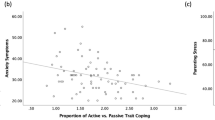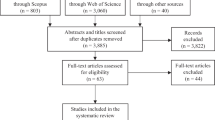Abstract
Ninety-eight mothers of healthy firstborn infants 0 to 6 months old were randomly assigned to listen to 10-min of infant crying or infant cooing while continuously rating subjective feelings of frustration. Participants completed pre-test measures of depressed mood, empathy, and trait anger and post-test measures of infant-related harm thoughts, negative and positive emotions, and urge to comfort and to flee. Twenty-three (23.5 %) participants endorsed unwanted thoughts of active harm (e.g., throwing, yelling at, shaking the infant). Women in the cry condition were more likely than women in the coo condition to report thoughts of harm. Women in the cry condition who endorsed thoughts of harm reported higher frustration levels over the 10 min of crying, higher levels of post-test negative emotions, and stronger urges to flee the infant but not stronger urges to comfort the infant. Trait anger and personal distress empathy predicted the occurrence of unwanted thoughts of infant harm, whereas negative mood did not. Unwanted, intrusive, infant-related thoughts of harm may be triggered by prolonged infant crying, are predicted by personal distress empathy and a tendency to experience anger, and are associated with higher frustration, negative emotions, and the urge to escape the infant.

Similar content being viewed by others
References
Abramowitz JS, Schwartz SA, Moore KM (2003) Obsessional thoughts in postpartum females and their partners: content, severity, and relationship with depression. J Clin Psychol Med Settings 10:157–164
Abramowitz JS, Khandker M, Nelson CA, Deacon BJ, Rygwall R (2006) The role of cognitive factors in the pathogenesis of obsessive–compulsive symptoms: a prospective study. Behav Res Ther 44:1361–1374
Abramowitz JS, Nelson CA, Rygwall R, Khandker M (2007) The cognitive mediation of obsessive–compulsive symptoms: a longitudinal study. J Anxiety Disord 21:91–104
Barr RG (2000) Excessive crying. In: Sameroff AJ, Lewis M, Miller SM (eds) Handbook of developmental psychopathology, 2nd edn. Kluwer Academic/Plenum Press, New York, pp 327–350
Barr RG (2012) Preventing abusive head trauma resulting from a failure of normal interaction between infants and their caregivers. Proc Natl Acad Sci 109:17294–17301
Barr RG, National Center on Shaken Baby Syndrome (2004) Period of purple crying® shaken baby syndrome prevention program. National Center on Shaken Baby Syndrome, Ogden
Brewin CR, Hunter E, Carroll F, Tata P (1996) Intrusive memories in depression: an index of schema activation? Psychol Med 26:1271–1276
Coo S, Milgrom J, Trinder J (2014) Mood and objective and subjective measures of sleep during the late pregnancy and the postpartum period. Behav Sleep Med 12:317–330
Davis MH (1983) Measuring individual differences in empathy: evidence for a multidimensional approach. J Pers Soc Psychol 44:113–126
Eberhard-Gran M, Eskild A, Tambs K, Opjordsmoen S, Samuelsen SO (2001) Review of validation studies of the Edinburgh postnatal depression scale. Acta Psychiatr Scand 104:243–249
Fairbrother N, Abramowitz JS (2007) New parenthood as a risk factor for the development of obsessional problems. Behav Res Ther 45:2155–2163
Fairbrother N, Abramowitz JS (2014) Postpartum obsessive–compulsive disorder. Handbook of perinatal psychology. Ed. A. Wenzel. Oxford University Press
Fairbrother N, Woody SR (2008) New mothers’ thoughts of harm related to the newborn. Arch Women’s Ment Health 11:221–229
Freeston MH, Ladouceur R, Thibodeau N, Gagnon F (1991) Cognitive intrusions in a non-clinical population: I. Response style, subjective experience, and appraisal. Behav Res Ther 29:585–597
Fujiwara T, Barr RG, Brant R, Barr M (2011) Infant distress at 5 weeks of age and caregiver frustration. J Pediatr 159(3):425–430
Horowitz MJ (1975) Intrusive and repetitive thoughts after experimental stress. Arch Gen Psychiatry 32:1457–1463
Insana SP, Costello CR, Montgomery-Downs HE (2011) Perceptions of partner sleep and mood: postpartum couples’ relationship satisfaction. J Sex Marital Ther 37:428–440
Jomeen J, Martin CR (2005) Confirmation of an occluded anxiety component within the Edinburgh postnatal depression scale (EPDS) during early pregnancy. J Reprod Infant Psychol 23:143–154
Kesler H, Dias MS, Shaffer M, Rottmund C, Cappos K, Thomas NJ (2008) Demographics of abusive head trauma in the Commonwealth of Pennsylvania. J Neurosurg Pediatr 1:351–356
Klinger E (1996) The contents of thoughts: interference as the downside of adaptive normal mechanisms in thought flow. In: Sarason IG, Pierce GR, Sarason BR (eds) Cognitive interference: theories, methods, and findings. Lawrence Erlbaum Associates, Mahwah, pp 3–23
Lekman JF, Mayes LC, Feldman R, Evans DW, King RA, Cohen DJ (1999) Early parental preoccupations and behaviors and their possible relationship to the symptoms of obsessive–compulsive disorder. Acta Psychiatr Scand 100:1–26
Murray AD (1979) Infant crying as an elicitor of parental behavior: an examination of two models. Psychol Bull 86:191–215
Niler ER, Beck SJ (1989) The relationship among guilt, dysphoria, anxiety and obsessions in a normal population. Behav Res Ther 27:213–220
Novaco RW, Taylor JL (2004) Assessment of anger and aggression in male offenders with developmental disabilities. Psychol Assess 16:42–50
Parkinson L, Rachman SJ (1980) Are intrusive thoughts subject to habituation? Behav Res Ther 18:409–418
Parkinson L, Rachman S (1981) Part II. The nature of intrusive thoughts. Adv Behav Res Ther 3:101–110
Pulos S, Elison J, Lennon R (2004) The hierarchical structure of the interpersonal reactivity index. Soc Behav Personal 32:355–360
Purdon C, Clark DA (1993) Obsessive intrusive thoughts in nonclinical subjects: I. Content and relation with depressive, anxious and obsessional symptoms. Behav Res Ther 31:713–720
Rachman S (1998) A cognitive theory of obsessions: elaborations. Behav Res Ther 36:385–401
Rachman S, de Silva P (1978) Abnormal and normal obsessions. Behav Res Ther 16:233–248
Ross LE, Murray BJ, Steiner M (2005) Sleep and perinatal mood disorders: a critical review. J Psychiatry Neurosci 30:247–256
Salkovskis PM, Harrison J (1984) Abnormal and normal obsessions: a replication. Behav Res Ther 22:549–552
Spielberger CD, Crane RS, Kearns WD, Pellegrin KL, Rickman RL, Johnson EH (1999) STAXI-II. State trait anger expression inventory-2: professional manual. Psychological Assessment Resources, Lutz
Starling SP, Holden JR (2000) Perpetrators of abusive head trauma: a comparison of two geographic populations. South Med J 93:463–465
Starling SP, Holden JR, Jenny C (1995) Abusive head trauma: the relationship of perpetrators to their victims. Pediatrics 95:259–262
Timpano KR, Carbonella JY, Bernert RA, Schmidt NB (2014) Obsessive compulsive symptoms and sleep difficulties: exploring the unique relationship between insomnia and obsessions. J Psychiatr Res 57:101–107
Wisner KL, Peindl KS, Gigliotti T, Hanusa BH (1999) Obsessions and compulsions in women with postpartum depression. J Clin Psychiatry 60:176–180
Wroe AL, Salkovskis PM, Richards HC (2000) ‘Now I know it could happen, I have to prevent it’: a clinical study of the specificity of intrusive thoughts and the decision to prevent harm. Behav Cogn Psychother 28:63–70
Acknowledgments
We would first like to thank the wonderful women who offered their time to this research. We would also like to thank Cynthia Lee, Erin Miller, and Robyn Cater who provided invaluable support and assistance to the project.
Author information
Authors and Affiliations
Corresponding author
Rights and permissions
About this article
Cite this article
Fairbrother, N., Barr, R.G., Pauwels, J. et al. Maternal thoughts of harm in response to infant crying: an experimental analysis. Arch Womens Ment Health 18, 447–455 (2015). https://doi.org/10.1007/s00737-014-0471-2
Received:
Accepted:
Published:
Issue Date:
DOI: https://doi.org/10.1007/s00737-014-0471-2




